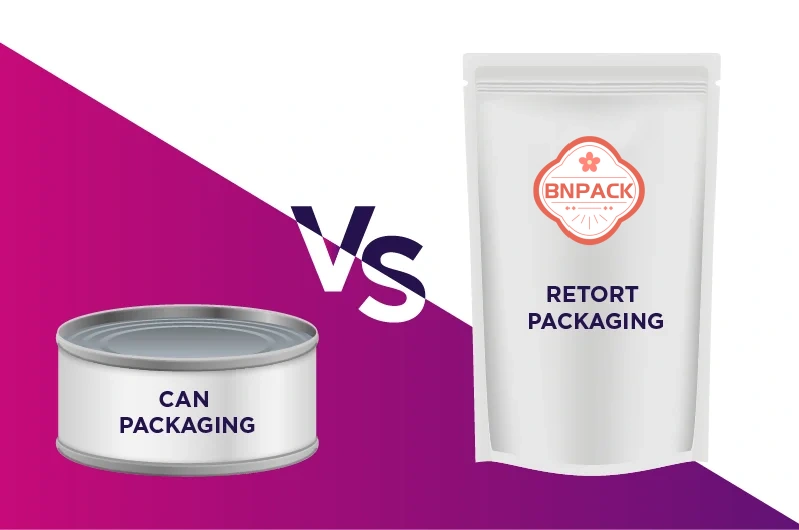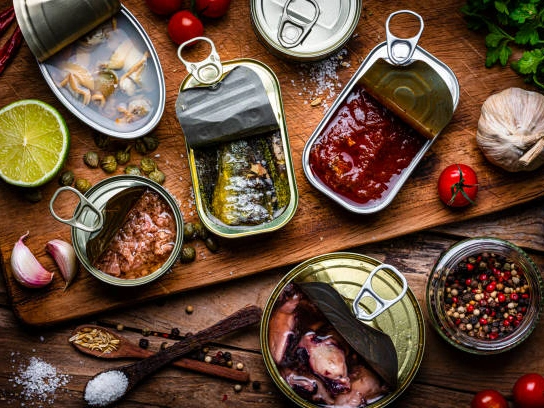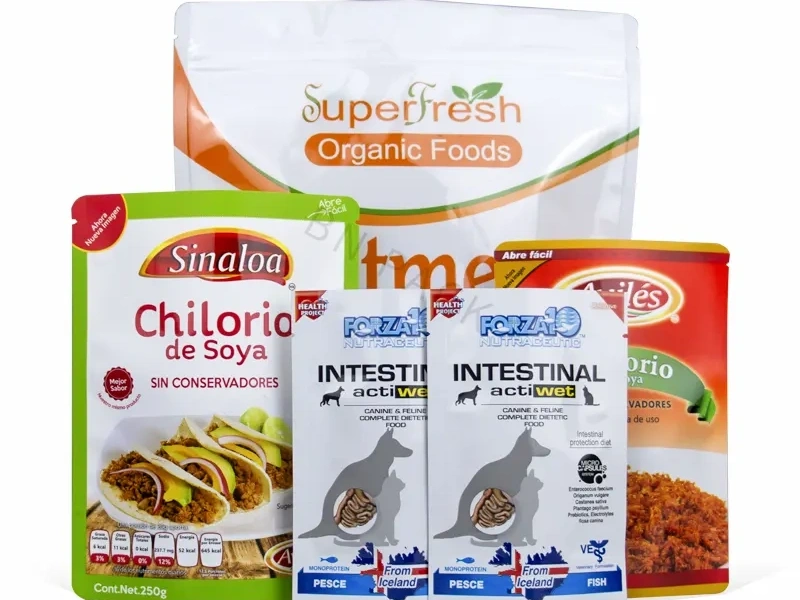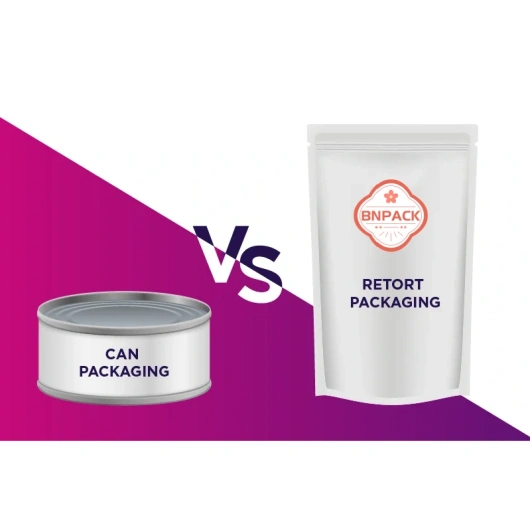Packaging is ubiquitous in our daily lives and we often take it for granted. Whether we are buying groceries, eating fast food or purchasing household items, the packaging of the product plays an important role.
Every time we stand in front of the supermarket shelf, we are faced with a variety of packaging, two of the most common ones are retort pouches and cans. Let’s see what the difference is between retort pouch vs can!

Definition and General Overview
What is a Retort Pouch?
A retort pouch is a flexible, multi-layer packaging solution composed of materials such as plastic, aluminum foil, and other specialized films. These layers work in tandem to create a strong barrier against oxygen, moisture, and light. The pouch can be heat-sealed, allowing for efficient filling and sealing processes. It comes in various sizes and shapes, adapting well to different product volumes and forms.
What is a Can?
On the other hand, a can is a rigid container typically made of metal, either aluminum or steel. Aluminum cans are known for their lightweight nature, while steel cans often require coatings to prevent corrosion. Cans are designed with standard sizes and are highly stackable, which is beneficial for storage and transportation. They are equipped with different types of closures, like pull – tabs or screw – caps, for easy access to the product inside.
Importance of the Comparison
In the packaging industry, understanding the differences between retort pouches and cans is crucial. Each packaging type has its own set of advantages and limitations. For example, retort pouches offer flexibility in design and lower material costs in some cases, while cans provide excellent durability and long-term preservation. This knowledge helps packaging professionals select the most suitable option for different products, optimizing production efficiency and product quality.
For consumers, the choice between products packaged in retort pouches and cans can impact their overall experience. Pouches might be more convenient for on-the-go consumption due to their light weight and easy-to-open features, while cans might be preferred for their perceived sturdiness and traditional appeal. Businesses, meanwhile, need to consider factors such as cost-effectiveness, brand image, and environmental impact when choosing between these two packaging types. A well-informed decision can lead to increased customer satisfaction, reduced costs, and a more sustainable business model.
Retort Pouch vs Can Physical Characteristics

Retort Pouch
Material Composition
Retort pouches typically consist of multiple layers. The innermost layer is often a food-grade plastic, ensuring that direct contact with the product is safe. This layer provides flexibility and some basic barrier properties. The middle layer is usually aluminum foil, which acts as an excellent barrier against oxygen, moisture, and light. It significantly extends the product’s shelf life by blocking these elements. The outermost layer is another plastic layer, offering mechanical strength and protection to the inner layers. Each layer plays a crucial role in maintaining product quality.
Flexibility
The flexibility of retort pouches has several implications. In storage, they can be easily stacked, taking up less space compared to rigid containers. During handling, their pliability makes them less likely to break or cause damage. Unique packaging shapes are possible, such as stand-up pouches with spouts, which are convenient for products like sauces or liquid detergents. This flexibility also allows for better adaptation to irregularly shaped products.
Size and Weight
Retort pouches come in a wide range of sizes, from small single-serving pouches for condiments to large ones for family-sized meals. Their weight is substantially lighter than cans. This reduced weight not only eases transportation but also cuts down on shipping costs. For consumers, it means more convenient carrying, especially for on – the – go consumption.
Can
Material (Metal Types)
Aluminum cans are favored for their lightweight nature. They are highly corrosion-resistant, making them suitable for various products, especially beverages. Steel cans, on the other hand, are stronger but require coatings to prevent rusting. These coatings can be epoxy-based or tin-plated, depending on the product inside.
Rigidity
The rigidity of cans provides excellent protection against external impacts. They can withstand rough handling during transportation and storage without easily denting or puncturing. Their stackability is high, allowing for efficient storage in warehouses and on store shelves. This stability ensures that products remain intact and undamaged.
Standard Sizes
Cans come in well-established standard sizes. In the beverage industry, common sizes include 330 ml and 500 ml. These sizes are industry-wide standardized, making it easier for manufacturers to produce, distribute, and for consumers to recognize and compare products. This standardization also simplifies packaging machinery design and usage.
Retort Pouch vs Can Manufacturing Process

Retort Pouch
Film Extrusion and Lamination
In the production of retort pouches, film extrusion is the initial step. Polymer resins are melted and forced through a die to form thin, continuous films. These films, which may include plastic and aluminum-based materials, are then laminated together. The lamination process bonds the different layers using adhesives or heat-activated polymers. Quality control during this stage is crucial. Specialized equipment is used to monitor the thickness of each layer, ensuring uniform distribution. Any deviation can compromise the pouch’s barrier properties. For example, an uneven aluminum layer might lead to reduced oxygen and light protection.
Pouch Forming
There are two main methods for pouch forming. Vertical form – fill – seal machines are commonly used. Here, a continuous roll of laminated film is formed into a tube, filled with the product, and then heat-sealed at the bottom and top. Horizontal form-fill-seal machines work differently, forming the pouch from a flat sheet of film, filling it, and sealing the sides. Machinery involved includes sophisticated formers, fillers, and sealers, all precisely calibrated to handle the delicate films and ensure accurate filling and sealing.
Filling and Sealing
For various products, different filling techniques are employed. Liquids can be filled using gravity-fed or positive-displacement pumps, ensuring accurate volumes. Solids and semi-solids may require auger – type fillers. When it comes to sealing, heat-seal is a common method, where heat is applied to melt the plastic layers and bond them together. Pulse-seal, which uses short bursts of high-energy current, is also used, especially for heat-sensitive products. The effectiveness of these seals is tested through leak-detection methods to guarantee product integrity.
Can
Metal Plate Stamping
The process of making cans starts with metal plate stamping. Metal sheets, either aluminum or steel, are fed into stamping presses. These presses use dies to cut and shape the metal into the basic can body. Precision is of utmost importance. Even a slight misalignment in the stamping can lead to issues in subsequent manufacturing steps, such as problems with can body assembly or sealing. The stamping process must be carefully controlled to ensure consistent dimensions and smooth edges.
Can Body Manufacturing
Once the can body is stamped, it needs to be fabricated into a complete structure. For aluminum cans, welding is often used to join the edges, creating a seamless body. Steel cans may use seaming techniques, where the edges are mechanically interlocked and sealed with a coating. Quality assurance for leak-proof seams is rigorous. Pressure and vacuum tests are conducted to ensure that no product leakage occurs during storage and transportation.
Filling and Capping
Filling systems for cans vary depending on the product viscosity. Thin-liquid products like beverages can be filled using high-speed volumetric fillers. Thicker products may require piston-type fillers. Different types of closures are used. Screw-caps are often used for products that need to be resealed multiple times, while pull – tabs are convenient for single – use products like canned drinks. The manufacturing of these closures involves precision molding and finishing processes to ensure a proper fit and easy opening for consumers.
Retort Pouch vs Can Barrier Properties
Retort pouches offer excellent barrier properties. The aluminum layer acts as a key oxygen barrier, blocking oxygen ingress, which is further aided by the low permeability plastic layer. This is critical for oxygen-sensitive products, preventing oxidation and deterioration, thereby extending shelf life. The plastic layer, especially that of high-density polyethylene, forms a strong moisture barrier, allowing a wide range of products to maintain optimal humidity levels. Additionally, the aluminum layer shields the product from harmful light, protecting light-sensitive items and ensuring product integrity.
Cans made from aluminum or steel have excellent barrier properties. They are naturally resistant to oxygen and moisture, and the oxide layer of aluminum and protective coatings of steel (such as epoxy or tin) prevent products from rusting and deteriorating, making them ideal for long-term storage. In addition, their opaque nature completely blocks light. This protects light-sensitive items (such as craft beer and nutrient-rich juices) from photochemical reactions, ensuring consistent product quality from production to consumption.
Retort Pouch vs Can Shelf Life and Storage
Retort bags are made of heat-resistant multi-layer materials that withstand high-temperature sterilization processes well. This ensures effective elimination of harmful microorganisms. During the retort process, they maintain product quality by minimizing nutrient losses and flavor changes. The shelf life of different products in retort bags varies, with some products lasting from months to years. Storage conditions such as temperature and humidity have a significant impact on this, as higher temperatures and humidity accelerate product degradation.
Cans are sterilized through traditional canning methods, such as high-temperature treatment, to ensure product safety by eliminating spoilage organisms. Their sturdy structure and excellent barrier properties prevent recontamination. Cans have significant long-term storage potential. For example, canned meats and vegetables can be stored for years without noticeable quality loss, making them a reliable choice for long-term food preservation.
Cost-Effectiveness
Retort pouches offer cost-effectiveness in multiple ways. Material costs are relatively favorable when comparing raw materials for components, and economies of scale further reduce expenses during production. Their manufacturing incurs lower machinery and labor costs, with less energy consumption than can production. In terms of logistics, the lightweight and space – saving design cuts down shipping and storage costs significantly, making them an attractive option for businesses aiming to optimize costs.
Cans have different cost dynamics. Material costs, including metal sheets and coatings, are subject to price fluctuations. Their manufacturing involves high-cost machinery and complex, energy-intensive processes. When it comes to transportation and storage, cans, being heavier and bulkier than pouches, demand more space and incur higher costs. These factors impact large-scale transportation and storage, adding to the overall cost burden for businesses.
Market Trends and Future Outlook

Retort pouches are witnessing growing popularity in specific markets. In the food and beverage sectors, they’re increasingly used for innovative products like single-serve meal kits. Their expansion in developing economies is driven by cost-effectiveness and convenience. Technologically, new materials are emerging, enhancing barrier properties and recyclability. Manufacturing techniques are also evolving for better efficiency. Potential growth areas lie in niche markets such as high-end pet food and specialized pharmaceutical products, where pouches’ flexibility and customization options can be fully exploited.
Cans maintain stability in traditional markets, dominating product categories like canned fruits and carbonated drinks, backed by strong brand loyalty. However, innovation is rife. New closure systems are being developed for easier access, and lightweighting initiatives aim to reduce material use. These efforts enhance both functionality and aesthetics. Cans are adapting to changing consumer demands by addressing environmental concerns, like improving recyclability, and offering greater convenience, ensuring their continued relevance in the packaging landscape.
Conclusion
In conclusion, the choice between retort pouches and cans depends on various factors such as product type, cost considerations, and environmental concerns. Looking ahead, both packaging types are expected to continue evolving to better serve consumer and industry needs.
